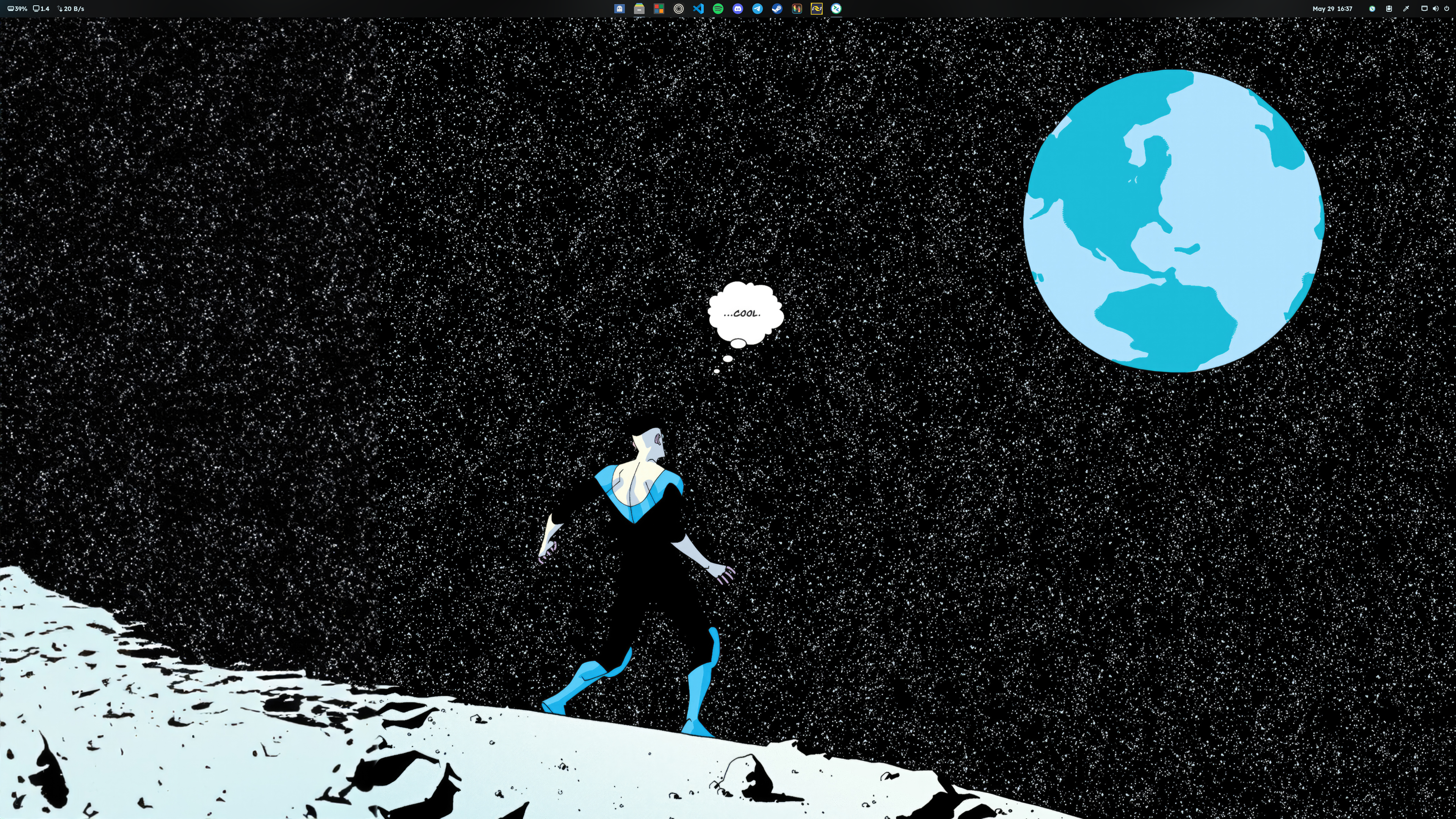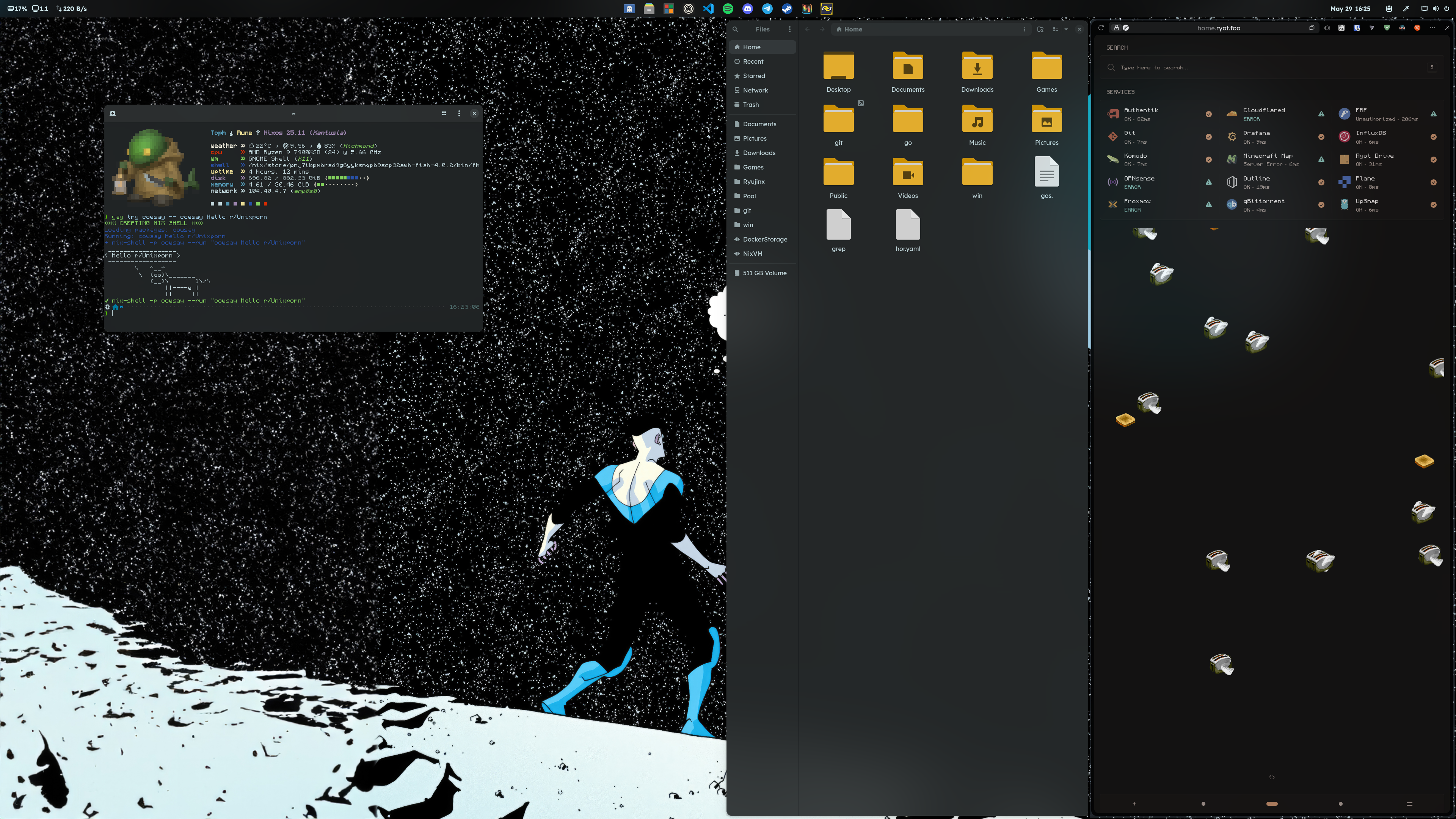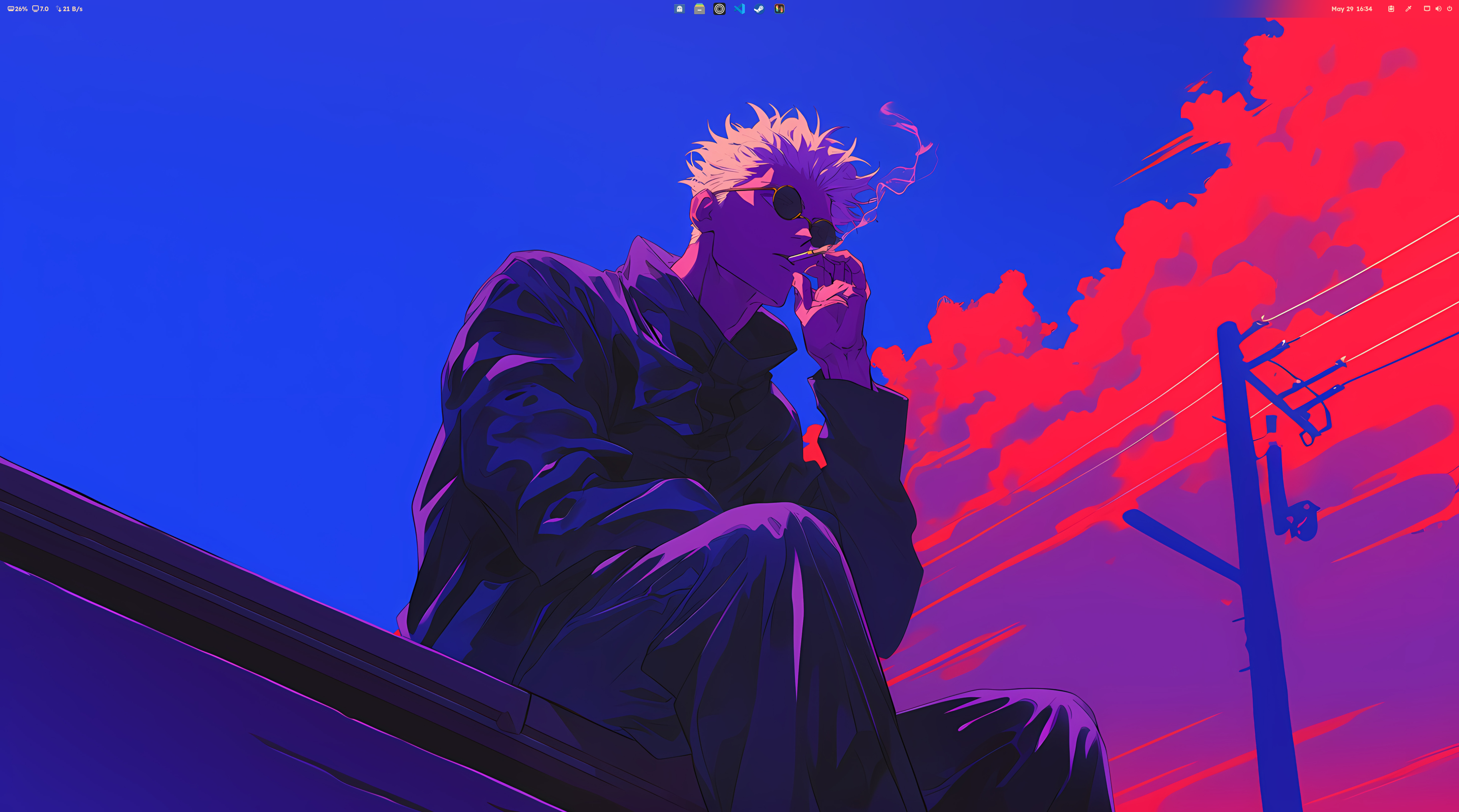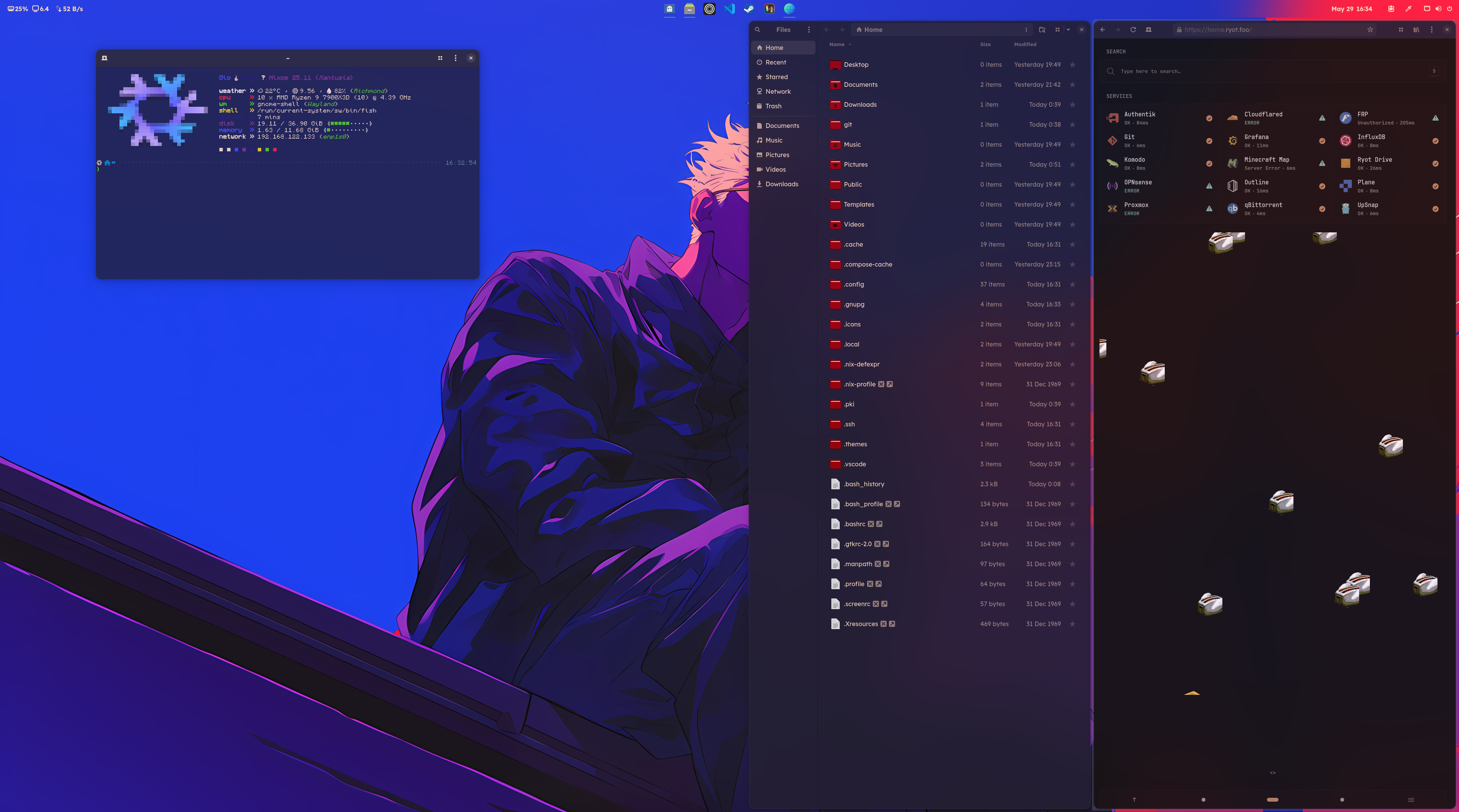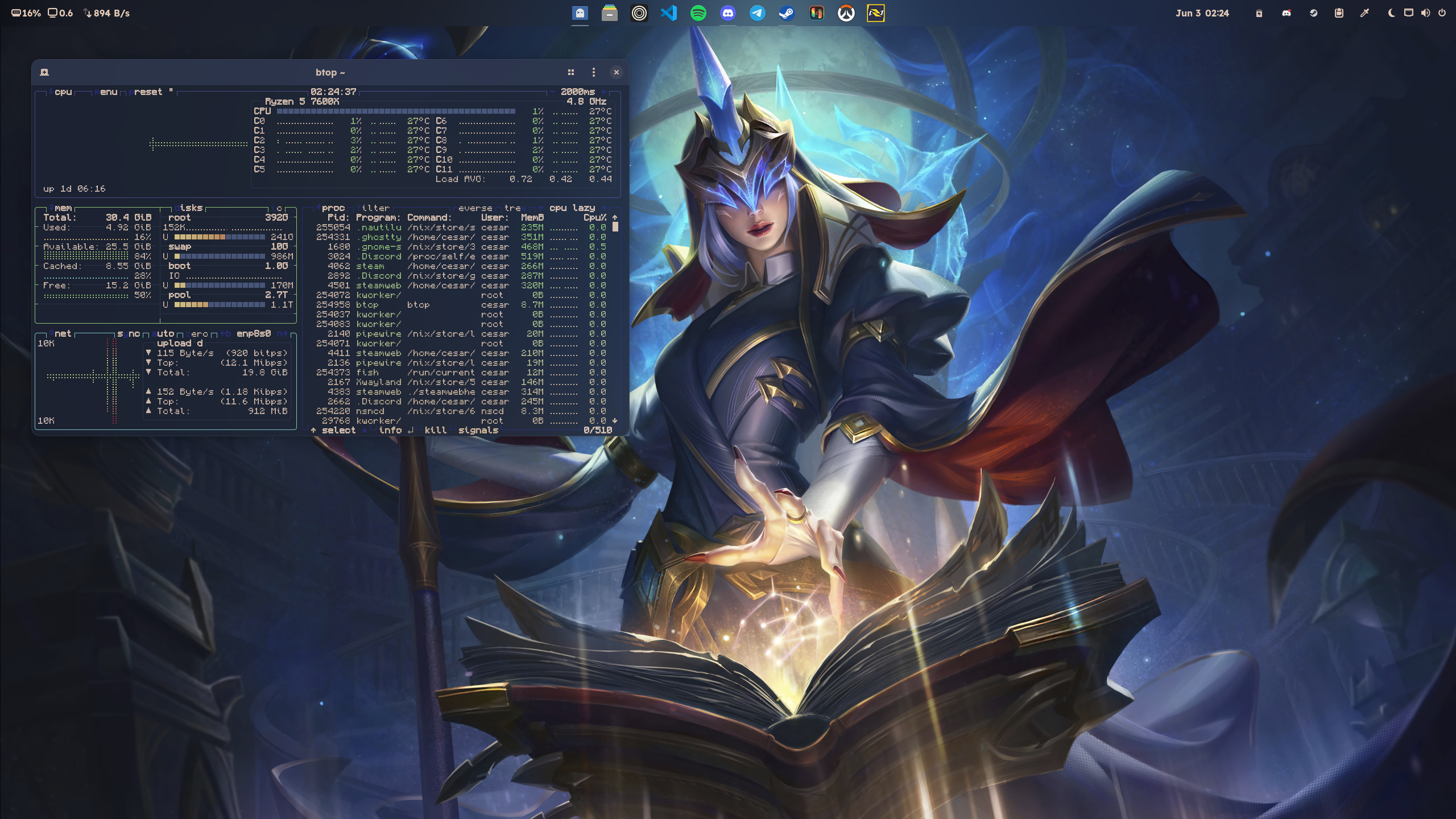| .git-crypt | ||
| .vscode | ||
| home | ||
| hosts | ||
| lib | ||
| modules | ||
| overlays | ||
| pkgs | ||
| .gitattributes | ||
| .gitignore | ||
| flake.lock | ||
| flake.nix | ||
| readme.md | ||
| secrets.nix | ||
| shell.nix | ||
❄️ dot.nix
My NixOS & Home Manager Multi User/Host Configuration
A modular Nix flake managing multiple systems and users with a focus on reproducibility and ease of maintenance.
🏗️ Architecture Overview
This repository follows a layered, modular approach that separates system-level configurations from user environments, while promoting code reuse across different hosts and users.
📁 dot.nix/
├── ❄️ flake.nix # Central entry point & dependency management
├── 🔐 secrets.nix # Encrypted secrets (git-crypt)
├── 🏠 hosts/ # System-level configurations
├── 👤 home/ # User environment configurations
├── 📦 modules/ # Reusable configuration modules
├── 🎨 overlays/ # Package customizations
├── 📋 pkgs/ # Custom package definitions
└── 🛠️ lib/ # Helper functions & utilities
🎯 Core Components
Flake Management (flake.nix)
The heart of the configuration, managing:
- External Dependencies:
nixpkgs,home-manager,stylix,hardware modules,solaar,snapraid-aio,chaotic - System Outputs: Complete NixOS configurations for each host
- Custom Packages: Exposed packages from
pkgs/ - Overlays: Package modifications and additions
Secret Management
- Encryption:
git-cryptsecures sensitive data insecrets.nix - Structure: Defined by
modules/global/secret-spec.nix - Content: SSH keys, API tokens, hashed passwords, SMTP credentials
Configuration Specifications
host-spec.nix: Defines host attributes (hostname, user, hardware type, desktop environment,isMinimalfor server configurations)secret-spec.nix: Structures for secrets, firewall rules, Docker environments, Users, etc- Example secrets.nix
🏠 System Architecture (hosts/)
Global Configurations
hosts/global/
├── core/ # Essential base settings
│ ├── fonts.nix # Font management
│ ├── networking.nix # Network configuration
│ ├── ssh.nix # SSH server setup
│ └── user.nix # User account setup
└── common/ # Optional system features
├── audio.nix # PipeWire audio stack
├── gaming.nix # Steam, GameMode, hardware optimizations
├── gnome.nix # GNOME desktop environment
├── docker.nix # Docker setup
└── libvirt.nix # VM tools and management
Host-Specific Configurations
Each system in hosts/nixos/<hostname>/ contains:
default.nix: Main configuration importing globals + host-specific settingshardware.nix: Hardware-specific configuration (bootloader, filesystems, drivers)config/: Service-specific configurations (optional)
🖥️ Current Hosts
| Host | Type | Purpose | Hardware | Services |
|---|---|---|---|---|
| rune | Desktop | My workstation | Ryzen 9 7900X3D, RX 9070 XT | Gaming, Development, VMs |
| gojo | Desktop | Giovanni's workstation | Ryzen CPU, RX 6950 XT | Gaming, Development |
| haze | Desktop | Cesar's workstation | Ryzen 7, RX 6950 XT | Gaming, Development |
| sock | Server | Backup & Storage | Intel N150 | WIP; Hosted on Firewall |
| cloud | LXC Container | Storage & NFS | 4C/4GB | File storage, NFS server, Backups |
| komodo | LXC Container | Docker orchestration | 12C/30GB | Authentik, Komodo, Web services |
| proxy | LXC Container | Network proxy | 3C/2GB | Cloudflare tunnels, Caddy |
| nix | LXC Container | Development server | 10C/12GB | Remote development, VSCode server |
| vm | VM | Testing environment | Variable | System testing |
👤 User Environment (home/)
Global Home Configurations
home/global/
├── core/ # Essential user tools
│ ├── fastfetch/ # System info shell prompt with custom scripts
│ ├── fish/ # Shell configuration
│ ├── git.nix # Git setup with signing
│ └── ssh.nix # SSH client configuration
└── common/ # Optional user applications
├── gaming/ # Gaming tools & emulator backups
├── gnome/ # GNOME-specific programs & settings
├── vscode/ # VS Code with patched SSH
└── zen.nix # Zen browser configuration
User-Specific Configurations
Each user in home/users/<username>/ includes:
- Theme Configuration: Stylix-based theming with custom color schemes
- Host Adaptations: Per-host overrides in
home/hosts/<hostname>/
👥 Current Users
| User | Theme | Primary Host | Desktop Setup |
|---|---|---|---|
| toph | Invincible (blue/yellow) | rune | GNOME + PaperWM |
| gio | Gojo (red/white) | gojo | GNOME + PaperWM |
| cesar | Soraka (purple/violet) | haze | GNOME + PaperWM |
🎨 Theming & Customization
Stylix Integration
- Unified Theming: Base16 color schemes applied system-wide
- Custom Schemes: User-specific YAML color definitions
- Coverage: GTK, terminal, VS Code (optional), wallpapers
- Fonts: Consistent typography (Lexend, Monocraft, Laila)
GNOME Customization
- Window Management: PaperWM for tiling workflow
- Extensions: Blur My Shell, Vitals, Pano clipboard, custom keybindings, ...
- Per-User: Customized dconf settings for each user's workflow
🔧 Notable Features
🎮 Gaming Infrastructure
- Steam Integration: Proton, GameScope, GameMode optimizations
- Emulator Backup System: Automated Borg backups for save files
# Automatic save backup for Ryujinx with inotify monitoring borg-wrapper -p "~/.config/Ryujinx/bis/user/save" -o "/pool/Backups/Switch/RyubingSaves" -m 30 -- ryujinx - Hardware Optimization: AMD GPU settings, VRR support
🗄️ Storage & Backup Strategy
Cloud Host (Storage Server)
- MergerFS Pool: Unified storage across multiple drives
- NFS Export: Mounted as
/poolon other hosts - SnapRAID Protection: Parity-based data protection
- Borg Backups: Incremental backups for critical data
Backup Chain
graph TD
A[SnapRAID Sync] --> B[Borg Docker Storage]
B --> C[Borg Forgejo]
C --> D[Notification]
E[inotify] --> F[Game Save Backups]
F --> G[Borg Game Saves]
🐳 Container Management
- Komodo Integration: Docker stack management through web UI
- Service Definitions: Authentik SSO, Caddy reverse proxy, various applications
- compose2nix: Docker Compose files converted to NixOS modules
🔐 Security & Access
- SSH Key Management: Automated deployment of public/private keys
- Cloudflare Integration: Zero Trust tunnels for external access
- ACME Certificates: Automated Let's Encrypt with DNS challenge
🚀 Usage & Deployment
Initial System Installation
For setting up a new system (in NixOS) with this configuration:
1. Clone Configuration Repository
# Get yay.nix temporarily for installation
nix shell github:Tophc7/yay.nix --extra-experimental-features flakes --extra-experimental-features nix-command --no-write-lock-file
# Clone the configuration repository using yay try
yay try git git-crypt micro
cd ~/Documents/
git clone https://github.com/tophc7/dot.nix
2. Unlock Encrypted Secrets
cd ~/Documents/dot.nix
git-crypt unlock <<path/to/symmetric.key>> # Or use GPG key
3. Configure Hardware Settings
-
Compare hardware configurations:
micro ~/Documents/dot.nix/hosts/nixos/gojo/hardware.nix micro /etc/nixos/hardware-configuration.nix -
Update hardware.nix with the
fileSystemsandswapDevicesfrom the generated/etc/nixos/hardware-configuration.nix
4. Install Configuration (TTY)
- Switch to TTY:
Ctrl+Alt+F2 - Login to TTY
- Rebuild system:
nix shell github:Tophc7/yay.nix --extra-experimental-features flakes --extra-experimental-features nix-command --no-write-lock-file yay rebuild -H gojo -p ~/Documents/dot.nix -e sudo reboot -f
Day-to-Day System Management
Once installed, use the integrated yay tool for all system management:
# Build and switch system configuration
yay rebuild
# Update flake inputs
yay update
# Clean up system
yay garbage
# Try packages temporarily
yay try fastfetch -- fastfetch
# Create archives
yay tar myfiles/
# Extract archives
yay untar myfiles.tar.zst
Environment Variables
FLAKE: Set to your flake directory to avoid using-pflag repeatedlyexport FLAKE="$HOME/Documents/dot.nix" yay rebuild # Will automatically use $FLAKE path
Custom Tools Integration
yay: Primary rebuild and management tool (see yay.nix)nh: Nix helper for cleaner rebuild outputborgtui: Custom TUI for managing Borg repositories
📚 Development Philosophy
Modularity
- Separation of Concerns: System vs. user configurations
- Reusable Components: Shared modules across hosts
- Parameterization: Host specs drive configuration choices
Maintainability
- Structured Secrets: Clearly defined secret specifications
- Documentation: Inline comments and clear naming
- Testing: VM configurations for safe testing
Flexibility
- Multiple Users: Support for different users with different preferences
- Host Adaptation: Same user config adapts to different machines
- Service Composition: Mix and match services per host needs
🔗 Key Technologies
| Category | Technologies |
|---|---|
| Core | NixOS, Home Manager, Nix Flakes |
| Desktop | GNOME, PaperWM, Stylix |
| Virtualization | libvirt, QEMU, LXC containers |
| Storage | MergerFS, SnapRAID, BorgBackup, NFS |
| Containers | Docker, Komodo |
| Security | git-crypt, ACME, Cloudflare |
| Monitoring | Apprise notifications, systemd timers |
📝 Quick Reference
Directory Structure
hosts/nixos/<name>/- System configurationshome/users/<name>/- User environmentshome/hosts/<name>/- Host-specific user overridesmodules/global/- Shared specificationspkgs/- Custom packagessecrets.nix- Encrypted secrets (git-crypt)
Key Files
flake.nix- Dependency management & outputsshell.nix- Recovery environmentmodules/global/host-spec.nix- Host attribute definitionsmodules/global/secret-spec.nix- Secret structure definitions
This configuration emphasizes reproducibility, security, and maintainability while supporting a complex multi-user, multi-host homelab environment. I quite love it, hope it serves as inspo to some of you out there.
